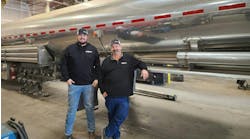THE past decade has seen a significant change in the materials platform trailer customers want for trailer flooring.
Trailer manufacturers have tried a little of everything to provide platform trailer customers with flooring to meet their needs. Various wood products, synthetic flooring based on different materials — including recycled tires — and metallic profiles (primarily aluminum) are among the materials that trailer manufacturers are using to provide the surface on which the freight rides.
But in recent years, there has been a significant shift toward the use of extruded aluminum. During the 1980s and 1990s, roughly 30% of platform trailers were spec'ed with aluminum flooring. That share now stands at 55-60%.
Carl Bumgardner, president of Royal Truck and Trailer in Dearborn, Michigan — which deals primarily with Fontaine and Benson, and handles flatbed, drop-deck, lowbed, and dump trailers — says the trend now in the northern U S is aluminum platforms with wood nailer strips.
“Aluminum is lighter than wood and seems to be as cheap as wood is today,” he says. “Nailer strips are in because they're less expensive for the manufacturer. Aluminum flooring usually comes 12“ wide. They can put a strip or two in between and don't have to cut or weld another piece of aluminum floor to make it a full aluminum floor. So it's a lot less money. The customer will nail blocks of wood down to wood nailer strips to help stabilize the load and keep it from shifting.”
Others see the market a little differently.
“Apitong used to be all there was,” says Chuck Guinn with Pinnacle Trailer Sales in suburban Nashville, Tennessee. “Then we saw a big shift over to aluminum. Lately it seems things have shifted back toward apitong because of its durability and lower costs.”
So why the ambiguity — and the changes? A good place to look may be the volatility of commodity prices in recent months. Price fluctuations for aluminum sometimes have outweighed the one constant attribute of aluminum — its light weight — as a material for trailer flooring. And the fluctuations have caused repercussions for trailer customers, manufacturers, and suppliers.
“When aluminum went up in price at the first of this year, our customers switched to wood flooring,” says Bill Schaffer, vice president of sales and marketing for Overseas Hardwoods, a supplier to most major platform trailer manufacturers. “It put a constraint on us because the forecast we had received from our customers was completely wrong. Then the price of aluminum came back to where it had been.
“Two years ago, steel prices went sky-high, and manufacturers began using more aluminum. But the price of aluminum caught up nine months later. When that happened, they switched over to wood floors. But six months later, lumber prices went up as well. Much of this has to do with the global impact on raw materials.”
Conventional wisdom — especially at a time of surging fuel prices — says that fleets are placing a premium on weight savings today. That is true, but not universally, even among customers who buy platform and drop-deck trailers.
Lightest not always brightest
Bumgardner's company sells trailers to fleets in the Midwest that want to minimize tare weight. Although they do not always take advantage of the extra cargo capacity that the lower tare weight provides, the lighter trailers give Royal Truck and Trailer customers the flexibility they need when transporting cargos of differing densities.
“Fleets are trying to run with the lightest weight trailer they can possibly buy, to position themselves to be able to haul anything anywhere,” he says.
Yet other applications do not fully utilize the weight savings, opting instead for the lower cost of wood. This is particularly true for specialized carriers.
“Most fleets are taking aluminum because they want lighter weight and want to maximize the weight on every haul,” Schaffer says. “The problem with that is they usually don't achieve maximum weight. In many instances, they'll haul whatever is available to haul versus having an idle truck and driver. If they pick up a load of lumber or brick, the shipping company is not going to break the unitized package or unit size to maximize a trailer's capacity of up to 50,000 pounds. If they're hauling steel coils or other large unit items that are already that weight, it makes sense. In some instances, if a fleet hauls wallboard or other light weight construction-type items, they're going to ‘cube out’ before they ‘weight out.’ In a case such as this, the carrying capacity of a trailer will not be reached.”
As is frequently the case, materials and the trailers of which they are made come with trade-offs. For example, trailer dealers report that fleets seem to be shifting to aluminum flooring if they want a lighter trailer capable of transporting a variety of goods. Fleets engaged in more dedicated service may opt for wood.
Durability a key
Walker Trailer Sales in Monroe, Louisiana, is one of the top dealers each year for several major platform and drop-deck trailer manufacturers. Ray Walker has seen the shift to aluminum flooring in the flatbed market, but he says wood is the material of choice for 90% of the drop-decks his company sells.
“Aluminum can handle the loads,” he says. “Aluminum and wood both can take abuse, but with wood, the abuse doesn't show as much. Aluminum can bend and crack. When it does, it's a little more difficult than wood to repair because you have to cut out the damaged section and weld in a new one. But when it comes to choosing between wood and aluminum for heavy-duty applications, I think it's a mindset issue more than anything else. The military drop-decks are all spec'ed with wood floors, but is that always the best choice?”
Perhaps not universally. Wood may get the majority of use for drop-deck trailers, but aluminum also has its advocates.
“We have a customer down in South Louisiana who bought a drop-deck trailer with an aluminum floor and steel sides,” Walker says. “He uses it in the oilfields there, which is pretty heavy-duty service. Choosing a flooring material still comes down to what the customer wants.”
Overseas Hardwoods founder Lee Robinson Sr says flatbed trailer flooring has to be durable because of the constant loading and unloading — typically by forklifts — twisting, flexing, and turning on good roads, bad roads, and sometimes no roads. It has to stand up to the ever-changing environment — snow, ice, rain, and sun.
Finding fewer flaws
Aluminum is a metal with unchanging physical properties. Wood, however, varies significantly by species. Trailer manufacturers have used a wide range of species over the years to floor platform trailers.
During the 1960s, domestic hardwood lumber — oak, beech, hickory, hard maple — was utilized extensively throughout the industry. But the concern was that domestic lumber from temperate forests has knots and other defects. To obtain adequate vehicular-grade flooring from domestic lumber, it must be defected — processed with trimming and ripping — which usually results in short-length pieces of 5' to 9' — and it is the end of the board where wood is most vulnerable. Domestic hardwoods also have limited enduring quality in exterior applications, and chemical treatment is necessary.
Some of these shortcomings were addressed when trailer manufacturers began using tropical hardwoods starting in the 1960s and early 1970s. Because tropical climates have relatively consistent temperatures, trees grow at a steadier rate than those in temperate climates. Growth rings are virtually nonexistent, and grain tends to be consistently tight throughout the tree. The result is strong lumber with reduced frequency of defects.
In addition, species such as apitong (also known as keruing) contain damar resin, which helps the wood endure outdoor elements. Lumber cut from these trees can average lengths of 12' to 14', which eliminates multiple short component pieces.
A global marketplace
Getting the wood is a bit more difficult than it used to be. China, with an exploding economy and infrastructure that is gearing up for the Beijing Olympics, is consuming vast quantities of the same types of wood that find applications in the trailer manufacturing industry.
“There is more competition for it, but we are getting what we need,” Robinson says.
Overseas Hardwoods buys lumber in a wide range of sizes because the company has markets other than truck/trailer flooring. The other applications enable the company to use small pieces that would not be usable in trailer flooring.
“That being the case, we are a better customer to the saw mills. We have a broad range of material we bring in from Southeast Asia.”
Volume purchasing makes the company more competitive, Robinson says, but the weak U S dollar is applying additional pressure.
Inventory buildup
Because of the international nature of the supply and the lead time required to get hardwood from Southeast Asia to the U S, forecasting demand for trailer flooring is critical.
“During trailer down times, there is a surge in the aftermarket,” Robinson says. “Although it's not nearly as big as the new trailer business, we've managed to get through the recessions by doing business with well-established companies that refloor or rebuild trailers. We seek that business. We learn what type of floor each trailer manufacturer uses, so we can easily supply aftermarket business and keep the wolf away from the door, so to speak.”
Of course, a willingness to carry inventory helps make the margin for error somewhat greater when the domestic platform trailer industry bounces back from downturns. Overseas Hardwoods typically keeps five million feet in inventory. Managing that inventory, however, can be a challenge.
“We have to keep second-guessing the trends and what's going to happen,” Robinson says. “When things slow down, we end up with a big inventory. Being by nature optimistic people, we always carry a lot more than we should because we invariably think things are going to turn around the next day, and often times they don't. That's one of the hazards of this business — the tendency to carry too much inventory.
Weather patterns half a world away also affect the supply of tropical hardwoods. The monsoon season starts in November and can last until March. When the monsoons come, mills cut way back on logging. So while the trees may grow at a relatively steady pace, production of lumber becomes quite seasonal.
“We try to buy more heavily in the fall and then schedule the shipments for early spring to match the seasonal aspect of logging,” Robinson says. “Also, if we have a contract on ocean freight, we will often bunch things to use an attractive rate. We have to have good friendships not only in the trailer industry but in the banking industry.”
The price fluctuations of aluminum and wood in recent years have affected the popularity of both materials for use in platform and drop-deck trailer flooring. Overall, the overriding trend in this decade has been a shift toward aluminum flooring, at least among platforms, with wood remaining more popular for the heavier drop-deck and specialty applications.
There is a sense that, barring major price spikes, aluminum will top out at between 55% and 60% of the market — at least until the “next big thing” comes along. Even then, expect the change to be gradual. Trailer flooring may be more evolutionary than revolutionary.
“It takes about eight or nine years for trailer flooring to evolve,” Schaffer says. “We are currently working on the next generation of flooring. We're not at the point where we're ready to make an announcement of what that's going to be. But we do know it's a changing business and that we have to keep working with OEMs to develop a product that will work for them.”








